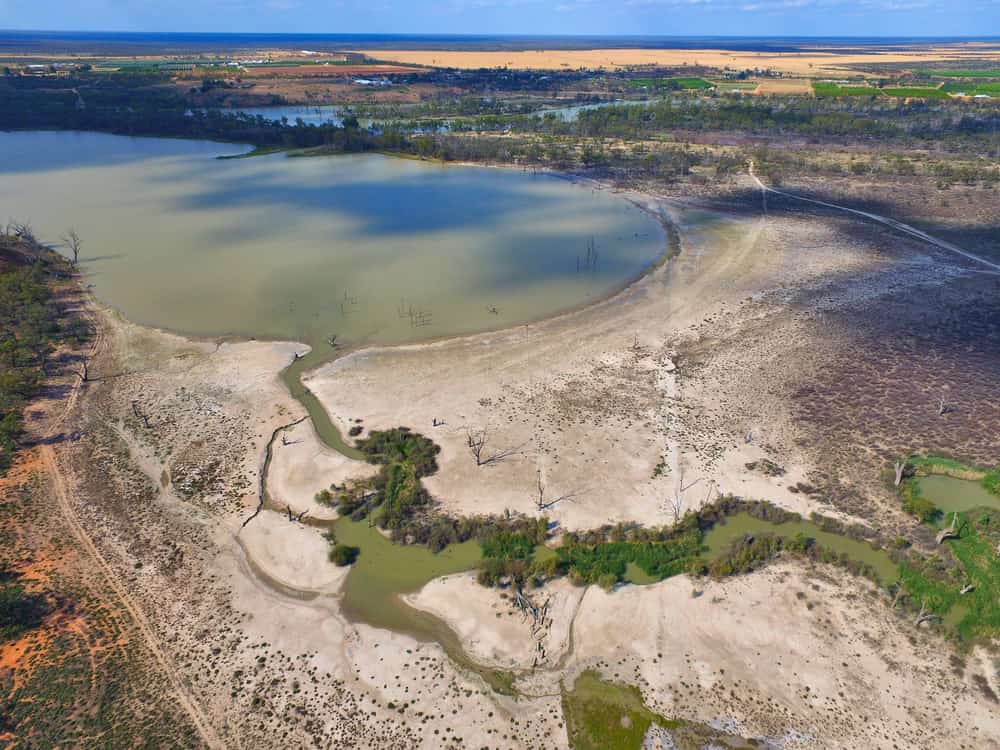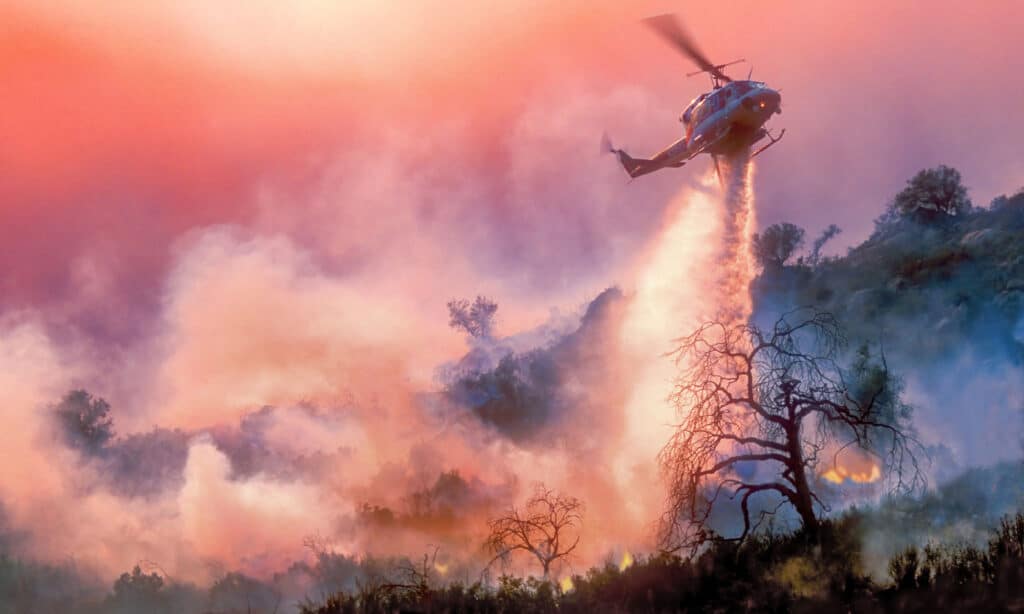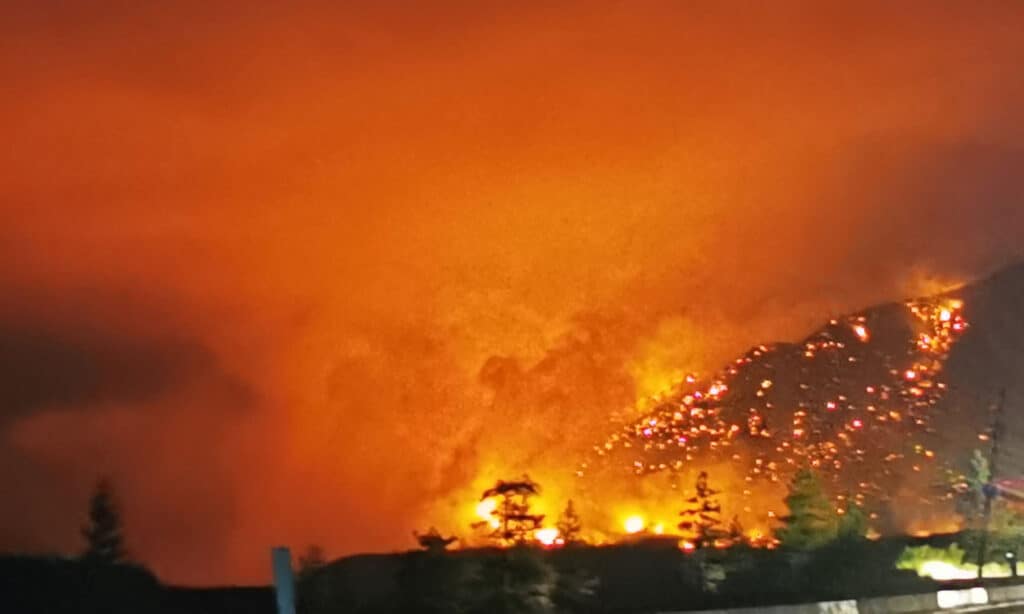In California’s vast and diverse landscape, wildfires threaten to wreak havoc year after year. The state’s wildfire season, a period of heightened danger and destruction, has become an increasingly formidable challenge for residents and authorities alike. With rising temperatures, prolonged droughts, and unpredictable weather patterns driven by climate change, the once-predictable boundaries of fire season have blurred.

Northern California
typically starts in June or July and extends through late October or November. However, Southern
California
experiences an earlier peak fire season, beginning in late spring (May-June) and lasting until October.
©iStock.com/Dimple Bhati
When Does the California Fire Season take place?
Fires can occur year-round in California, but the peak fire season varies between regions. Northern California typically starts in June or July and extends through late October or November. However, Southern California experiences an earlier peak fire season, beginning in late spring (May-June) and lasting until October.
Contrary to common belief, the most dangerous period for fires in California is not just limited to July and August. Although there might be fewer fires in September and October, the ones that do happen are more devastating, covering vast areas. This increased destructiveness results from a combination of dry vegetation due to hot summer weather and dry solid winds that sweep through the state during autumn.
What is the Duration of California’s Fire Season?
Each year, the fire season length in California depends on various factors, including summer temperatures, rainfall, and wind patterns. Historically, the majority of fires occur between May and October. However, recent data indicates that the fire season starts earlier and lasts longer each year due to rising temperatures and reduced rainfall, approaching a potential year-round fire risk.
When does the California Fire Season come to an end?
The California fire season usually concludes when heavy rainfall arrives. However, the impact of climate change has led to delayed fall precipitation, which can keep fires burning through the winter months.
Factors contributing to the risk of California Wildfires:
Drought: The combination of hot and dry climates significantly elevates the risk of wildfires. Drought conditions leave vegetation and soil with minimal moisture, turning the landscape into a highly flammable environment. Ongoing droughts in California have recently been of particular concern, with more than 97% of the state experiencing severe or extreme drought conditions.

The combination of hot and dry climates significantly elevates the risk of wildfires. Drought conditions leave vegetation and soil with minimal moisture, turning the landscape into a highly flammable environment.
©Hypervision Creative/Shutterstock.com
Wind: When strong winds accompany hot and dry weather, they become a significant fire hazard. For instance, the Santa Ana winds are powerful, dry downslope winds blowing from the mountains to the coast. They are capable of rapidly igniting and spreading wildfires. These winds can reach up to 40 miles per hour. In some cases, this leads to rapid and extensive fire spread and causes extreme destruction in a short period.
Human Activity: A substantial percentage, Humans cause up to 90% of wildfires in California through their activities. Common reasons for wildfire ignition include unattended campfires, fallen power lines, discarded cigarettes, vehicle accidents, or equipment that generates sparks, such as metal grinders.
How is California Wildfire Season changing?
The impact of climate change on California’s wildfire season is becoming increasingly evident. As warmer, drier conditions create the ideal environment for fires to thrive. The consequences of these changes are twofold. An escalation in both the frequency and severity of wildfires, led to unprecedented levels of devastation. Furthermore, the diminishing rainfall prolongs the dryness of vegetation well into late fall and winter. This amplifies the risk of extreme, late-season infernos. Last year’s incident statistics from CAL FIRE paint a grim picture of the escalating wildfire crisis.

A helicopter dropping water on a California wildfire.
©iStock.com/David Aughenbaugh
In 2021 alone, the state witnessed a staggering 8,835 recorded fires, engulfing 2,568,948 acres of land and causing damage to approximately 3,629 structures. The 2020-21 drought, characterized by arid winters followed by scorching summers, has left the soil and vegetation profoundly desiccated, rendering them increasingly susceptible to ignition.
Unveiling the Shift in California’s Wildfire History
An unmistakable trend emerges when delving into the annals of California’s wildfire history – the wildfire season is undergoing a profound transformation, stretching its grip far beyond the traditional bounds. Once limited to certain months, fires blaze fiercely throughout the winter, heralding an era of almost year-round fire vulnerability.
Underpinning this alarming evolution is a hotter, drier climate that increases the frequency of wildfires and magnifies their scale and intensity. Startling statistics reveal that eight of the state’s ten largest fires and twelve of the top twenty have erupted within the past five years. The year 2020 alone witnessed five of California’s twenty most enormous wildfires, underscoring the severity of the unfolding crisis.
The CAL FIRE incident archive paints a sad picture of the devastation of wildfires in 2020. Ravaging 4.3 million acres of precious land, consuming over 11,000 structures, and claiming the lives of 33 people, the wildfires left a trail of destruction that is difficult to fathom.
In Northern California, two recent incidents, the Dixie Fire in 2021 and the August Complex in 2020 are grim reminders of the immense challenge firefighting efforts face. Each scorching nearly a million acres and raging for months, these fires etched themselves into history as testaments to the growing threat.
Notably, the August Complex has earned the ominous distinction of being California’s largest recorded wildfire, even attaining the dubious title of the world’s first ‘gigafire,’ obliterating over a million acres and reducing more than 900 structures to ash.
In the past half-decade, California has endured the wrath of thirteen of its most destructive wildfires, obliterating 40,000 homes, businesses, and vital infrastructure. Amidst this backdrop, there remains hope, as individuals can contribute to mitigating the risk by learning about wildfire causes and adopting measures to fortify their homes.
What Will California Wildfire Season look like in 2023 After the Heavy Rainfall?
We brace ourselves for a more intense wildfire season in years of drought. However, this year is different after experiencing a historically wet winter and snowpack. Despite the moisture, the fire danger persists, but it has taken on a distinct character compared to the past few years.
Fire experts have assessed the 2023 U.S. wildfire forecast provided by Accuweather meteorologists, indicating that California could witness the burning of 400,000 to 1 million acres. This puts the state at an average or slightly above-average risk for fire danger as we progress into the summer.
To provide some context, the Dixie Fire alone in 2021, which occurred in Lassen Volcanic National Park, consumed nearly one million acres.
Dr. Craig Clements, the Director of the San Jose State University Wildfire Research Center, noted a difference this year as large fires aren’t expected in July as they were in previous years.
Accuweather warns that the fire threat will gradually increase throughout the summer due to the drying out of fuels amidst prolonged periods of warm and dry weather.
Dr. Andrew Latimer, the Director of the UC Davis Natural Reserve System, emphasized that while this year might be excellent for grazing cattle, the abundance of dry vegetation also means a higher potential for faster-spreading fires in grassland areas.
The wildfire peak season is expected to be in August and September for Northern California and from September to November for Central and Southern California, as predicted by Accuweather.
Despite the massive improvement in drought conditions brought about by winter storms, they also left a significant amount of fallen trees, branches, and limbs, which, according to Accuweather meteorologists, will contribute to the availability of fuels.
10 Wildfire Facts for Kids

While the annual number of wildfires in the
United States
has declined, the amount of land scorched by these fires has escalated.
©iStock.com/MichaelPenhallow
A wildfire, an uncontrolled fire that ignites in wildland areas like forests, grasslands, or the outskirts of urban spaces, remains a potent force.
When facing these fierce blazes, firefighters prioritize safeguarding human lives, structures, and vital resources. Embrace the knowledge of these wild facts about wildfires, and always remember the crucial importance of fire safety.
Fact #1:
Humans bear responsibility for a staggering 90% of annual wildfires arising from various activities. Carelessly discarded embers from campfires, sparks from car engines, or even intentional acts of arson can set the stage for disaster. Although controlled burns by professionals can promote healthy ecosystems, wildfires are a different beast – unpredictably dangerous and capable of causing immense harm to lives and communities.
Fact #2:
Three fundamental elements – heat, oxygen, and a fuel source – converge to ignite a fire, forming the aptly named “fire triangle.” Whether it’s a cigarette, a campfire spark, or dry wood, a combination of heat, air, and fuel can initiate a blaze. Dry weather and windy conditions, especially during droughts, exacerbate the wildfire risk, intensifying their potential devastation.
Fact #3:
Wildfires can race at an average speed of 14 miles per hour, contingent upon terrain, available fuel, and weather conditions. Fires can accelerate uphill due to rising smoke and heat that dry out fuel, while flames surging into treetops can lead to rapid, uncontrollable expansion.
Fact #4:
While wildfires occur in the central U.S. and on the East Coast, Western states bear the brunt of more significant, extensive blazes. States like Alaska, Arizona, California, and others witness important wildfire activity, often burning vast undeveloped land.
Fact #5:
Wildfires consume an astonishing 5-10 million acres in the United States annually, reflecting a staggering 223% increase in burned land since 1983. Despite human-caused fires dominating the count, lightning is the most significant natural cause of wildfires. While cold lightning rarely sparks fires, the longer-lasting hot lightning bolts can lead to more substantial and widespread infernos.
Fact #7:
The dance of wildfires encompasses various forms of movement, spread, and growth, each with its distinct characteristics.
Ground fires smolder through dead plant debris on the forest floor. Their slow-burning nature and minimal smoke make them stealthy and hard to detect. They can even wind their way through tree roots in their relentless journey.
Surface fires gracefully meander across the forest floor, claiming the lives of living vegetation and tender saplings in their path.
Crown fires are the acrobats of the wildfire world. They ascend to the tops of trees through winds or fuel sources like vines. Here, flames take flight, skipping from treetop to treetop with remarkable speed, painting the sky with their mesmerizing dance.
The most extreme is the tornado fire, a rare and astonishing phenomenon born of shifting air temperatures and winds. Within the churning fury of a tornado, flames may find refuge, burning both inside and outside the vortex. The swift and ferocious growth of these fires is a sight to behold.
Fact #8:
Contrary to its destructive reputation, fire plays an integral role in the balance of wildlands. This is akin to the vital dance of rain and snow within the natural cycle. Like the mighty sequoias, fire is not an adversary but an ally for specific trees. By creating space in the forest, fire allows more light and water to reach sequoia seedlings, helping them flourish. These magnificent giants withstand smaller, more frequent wildfires, and the heat from these fires unlocks the sequoia cones. It releases their seeds. Modern wildfire management incorporates controlled burns that cleanse the landscape of debris and potential fuel. This ensures that fire’s embrace benefits the environment while being skillfully tamed.
Fact #9:
The vast expanse of the Rocky Mountains gives birth to powerful wind currents that shape the fate of wildfires. When these winds head westward towards Southern California, they are christened Santa Ana winds. Conversely, when they journey eastward towards Colorado and Montana, they take on the name Chinook Winds. Their velocity, clocking in at 60-100 miles per hour, has propelled wildfires to dangerous heights in nearby states within mere minutes, underscoring the pivotal role wind patterns play in the spread and intensity of these infernos.
Fact #10:
In the ever-evolving tapestry of wildfire dynamics, a curious paradox emerges. While the annual number of wildfires in the United States has declined, the amount of land scorched by these fires escalated. Since 2000, an average of 7 million acres have been consumed by wildfires each year, more than double the average from the 1990s. Surprisingly, the current average number of annual wildfires stands at 70,000, lower than the 78,600 recorded in the 1990s. These intricate patterns beckon further study as we strive to comprehend the enigmatic forces shaping the future of wildfires.
What is the Largest Wildfire in California History?
The August Complex Fire, which struck Northern California during the 2020 fire season, is one of the most devastating wildfires in the state’s history. It was a massive complex of multiple fires that merged, scorching an estimated 1,032,648 acres—making it the largest wildfire ever recorded in California, surpassing one million acres for the first time. The fire started on August 16, 2020, and it took months of tireless efforts from various firefighting agencies to achieve full containment on November 25, 2020. The impact was profound, causing widespread destruction of forests, wildlife habitats, and communities, with numerous structures lost.

The August Complex Fire, which struck Northern California during the 2020 fire season, is one of the most devastating wildfires in the state’s history.
©iStock.com/ProPics Canada Media Ltd
How did the August Complex Fire Start?
The August Complex Fire originated from 38 fires sparked by lightning strikes on August 16–17, 2020. By August 30, four of the largest fires—the Doe, Tatham, Glade, and Hull—had merged. On September 9, the Doe Fire, which became the main fire of the August Complex, surpassed the 2018 Mendocino Complex. This became both the single-largest wildfire and the most extensive fire complex in recorded California history.
The following day, on September 10, the combined Doe Fire merged with the Elkhorn Fire. This was initially a separate incident, and the Hopkins Fire significantly increased. When the fire was finally extinguished on November 12, it ravaged an immense area. It scorched 1,032,648 acres (417,898 hectares) or approximately 1,614 square miles (4,180 square kilometers). To put this into perspective, it accounted for about 1% of California’s vast 100 million acres of land. It covers an area larger than the entire state of Rhode Island.
Primarily, the fire engulfed large sections of the Mendocino National Forest. Some portions spread into the Shasta-Trinity National Forest and Six Rivers National Forest in the north. The Yolla Bolly-Middle Eel Wilderness and Yuki Wilderness also suffered significant damage. The firefighting efforts were particularly challenging due to the rugged terrain, constant high winds, and record-breaking heat during the incident.
The August Complex Fire served as a stark reminder of the escalating wildfire risks in California. California needs ongoing fire prevention, firefighting techniques, and community preparedness improvements. This will address the challenges of climate change, drought conditions, and forest management practices.
The photo featured at the top of this post is © iStock.com/Dimple Bhati
Thank you for reading! Have some feedback for us? Contact the AZ Animals editorial team.






